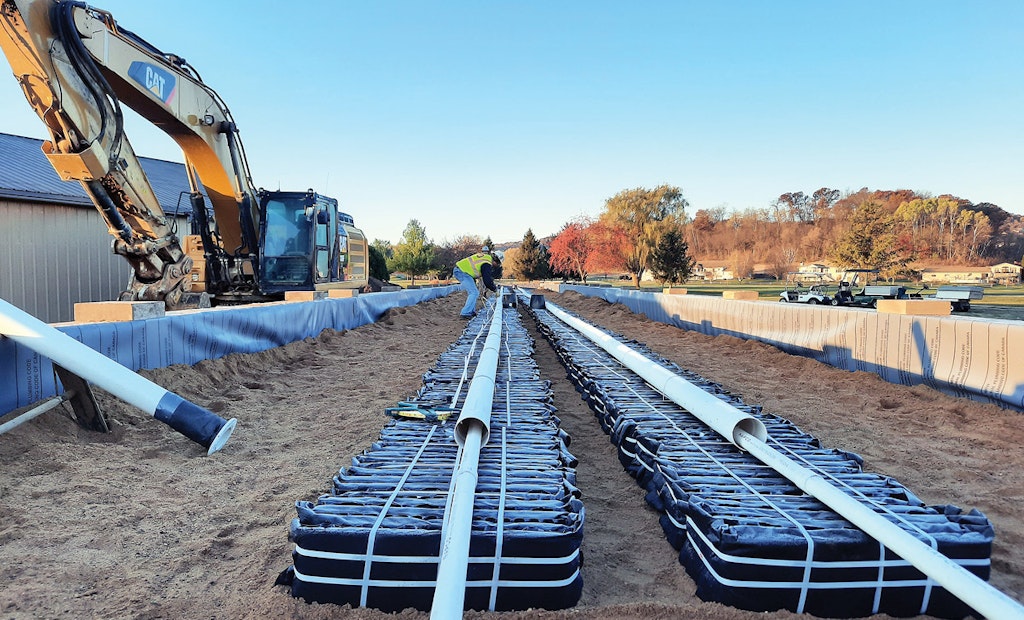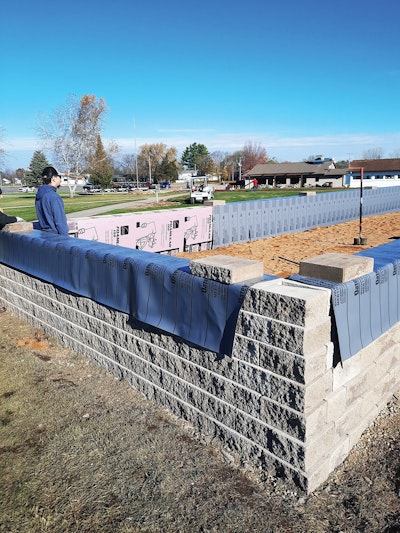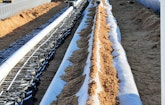
Jim Larson and Zeik Hellerude position spacers to hold laterals in place on top of the Eljen GSF units at the Fox Hollow Golf Course near La Crosse, Wisconsin. (All photos courtesy of Jim Larson and Mark Prevost)
For some years, the Fox Hollow Golf Course in western Wisconsin depended on holding tanks for its wastewater, but then the county informed owner Dave Cornell that a better solution was required. However, the course was surrounded mainly by small subdivisions and had little land to spare.
Dan McHugh, owner of McHugh Excavating and Plumbing in nearby Onalaska, Wisconsin, was brought in on the project in 2018 to look at solutions to the lack of space. A discussion among all the experts ultimately involved — including McHugh, Mark Prevost of First Supply, and Dale Schlieve, a septic designer and owner of CEC in Rhinelander, Wisconsin — produced an answer: aerobic treatment with White Knight units discharging to an Eljen GSF system built inside a very large box to save space. This is apparently the largest boxed Eljen system in existence.
Although he’s done larger Eljen systems, for example in a Northwoods camp, this one was unusual because of that space limitation, Schlieve says.
“You don’t want to interfere with the play, so we were limited where we could go,” he says. “You save a lot of room by building up without the end slopes, upslopes and downslopes.”
The system
Wastewater exits the clubhouse building through a 4-inch Schedule 40 PVC pipe. After about 15 feet, the pipe empties into a three-chamber 5,000-gallon concrete septic tank set deep to catch influent from the clubhouse and a tavern in the same building. The tank, and others in the treatment train, came from Crest Precast in nearby La Crescent, Minnesota, on the other side of the Mississippi River.
The first chamber captures grease, the second is septic, and the third equalizes flow. Wastewater next flows by gravity through an Orenco filter and into a 3,000-gallon pump tank. A pair of Goulds WE05H pumps sends wastewater through two Sim/Tech filters and into a pair of 4,000-gallon tanks connected in series. These hold a total of eight White Knight treatment units. A 3,000-gallon dosing tank is last. Two Goulds WE057 pumps, also with Sim/Tech filters, send water out to the mound.
A panel from SJE Rhombus controls the system.
A 200-foot run of 2-inch Schedule 40 PVC carries water from the dosing tank to the center of the mound, where a manifold splits the flow into laterals on top of the Eljen GSF units. The mound box is 14 feet 8 inches wide, 48 inches high and 178 feet long. It is built with cement landscaping blocks, so the finished system looks like a decorative bed where it sits next to the driving range.
Inside the box are about 550 yards of C33 sand. Because the box sat on a slight slope, one end has about 18 inches of sand between grade and the Eljen units, while the other end has about 30 inches of sand. About 17 inches of sand cover the Eljen units.
To do the job, the team used a Cat 336 excavator, a John Deere 85 excavator and a Cat 289 track loader from Gerke Excavating. (Between the time the project began and ended, McHugh sold his business of 40-plus years to Gerke Excavating of nearby Tomah, Wisconsin.)
A number of Gerke’s Kenworth quad-axle dump trucks, all no more than about three years old and with bodies from Michaels Truck Equipment in La Crosse, Wisconsin, brought in all the sand.
Challenges
Schlieve says his major challenge was figuring out the daily flow. Water use records were kept for the entire two years that the project was in the works, so there was a lot of information, he says. To arrive at a solid design flow number, he says, all the collected data had to be examined and adjusted to account for days of high and low usage of the course.
“That’s why we time-dosed the system, to take care of the peak times over a longer period of time,” Schlieve says.
Final flow numbers went to Knight Treatment Systems so they could calculate the number of White Knight units and tanks required, he says. The final design has extra capacity built in to handle extremes, he adds.
Installation by a crew of two took about three and a half weeks in October 2020, minus a couple of days lost to rain, McHugh says. That crew was Jim Larson, a longtime McHugh employee who served as plumber, equipment operator and foreman for the job. Also on the crew was Larson’s son-in-law Zeik Hellerude.
Larson, now a foreman/equipment operator for Gerke, says he had done one other Eljen installation, so he was familiar with the technology. The Fox Hollow job went smoothly other than taking more time because of the size of the mound, he says.
One nonstandard piece of equipment he used was 5 gallon plastic buckets. White Knight units must be at a specific height inside a tank, Larson says, and Prevost told him a 5 gallon bucket is just the right height. Larson used a hole saw on the buckets to ensure they won’t hold air, then fastened them to the bottoms of the White Knight units with stainless steel screws.
Tanks were buried near the clubhouse and next to a county road. That was OK except for the power lines overhead, McHugh says. Workers from the local utility came out to stabilize a utility pole and its transformers while the crew was digging beside it.
Installing two tanks under the power lines required the use of a 135-ton crane from Modern Crane Service in Onalaska. First the crane lifted the tanks off the truck and over the wires, setting the tanks on the ground. Then the crane reached under the wires, picked up the tanks and set them in their holes. (Other services came from Viking Electric in Holmen, Wisconsin, and Christen Nursery in Onalaska.)
While the system was being installed, the golf course remained open and relied on a holding tank that was pumped frequently, McHugh says. On the last day, the clubhouse had to close while the crew made the final connections to the new system. They started at 7 a.m., McHugh says, and were done by 10 a.m.









